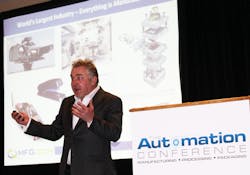Not that long ago, you had to be talented, skilled and experienced to use a camera, go in a darkroom and use chemicals to produce a picture. “Now, digitalization of photography has simplified photography and made producing a quality photo simple and repeatable—even a 6 year old can print a picture,” said Mitch Free, chairman and CEO of MFG.com. “Digitalization is beginning to affect manufacturing.”
Known for his visionary outlook on the future of manufacturing, Mitch Free shared his thoughts in a keynote address on Day One of The Automation Conference 2013 on how the new industrial revolution is being enabled by specific technology convergences. Free’s presentation expanded on his inclusion in Chapter 12 ("Factory in the Cloud") of Chris Anderson's new book "Makers: The New Industrial Revolution". The book explains how a generation of “makers” using the Web's innovation model will help drive the next big wave in the global economy. The new technologies of digital design, 3D printing (also called additive manufacturing) and global sourcing give everyone the power to invent and create products.
“Machinists are now in a commodity business,” said Free. There are 3D models online for producing parts and they’re extremely accurate. Production went digital, so it’s extremely repeatable “The ability to create a quality part is not a differentiator anymore,” he said.
The good news is, reshoring is real, Free said. “Manufacturing companies want and need to produce things locally” and digitalization enables that too, he said.
Additive manufacturing is another disruptive technology. “The real story is not that someone printed a gun and fired it,” said Free. “It’s that the technology allows anyone at home to produce anything he wants.”
Before the first industrial revolution, we were a world of cottage industries—individuals making things by hand. “We’re going to go back to cottage industries at a rate and range that we have never seen before, because the tools are falling into the hands of everybody.”
Right now, the materials used for additive manufacturing are not industrial-grade, but that may not be true for long, Free said.
“Manufacturing is commoditizing and it’s only going to accelerate. Now you have to figure out how are you going to evolve your business model,” Free contends. Change is hard and messy. There’s going to be a lot of bloodshed during this next industrial revolution”
So what can you do today? He said that what the winners are doing is focusing, creating a unique selling proposition, and casting wider net for customers online and globally. In short, “Take action: Buy a 3D printer and play with it. Let your kids play with it. Come up with a strategy.”
About the Author
Renee Bassett
Managing Editor

Leaders relevant to this article:
